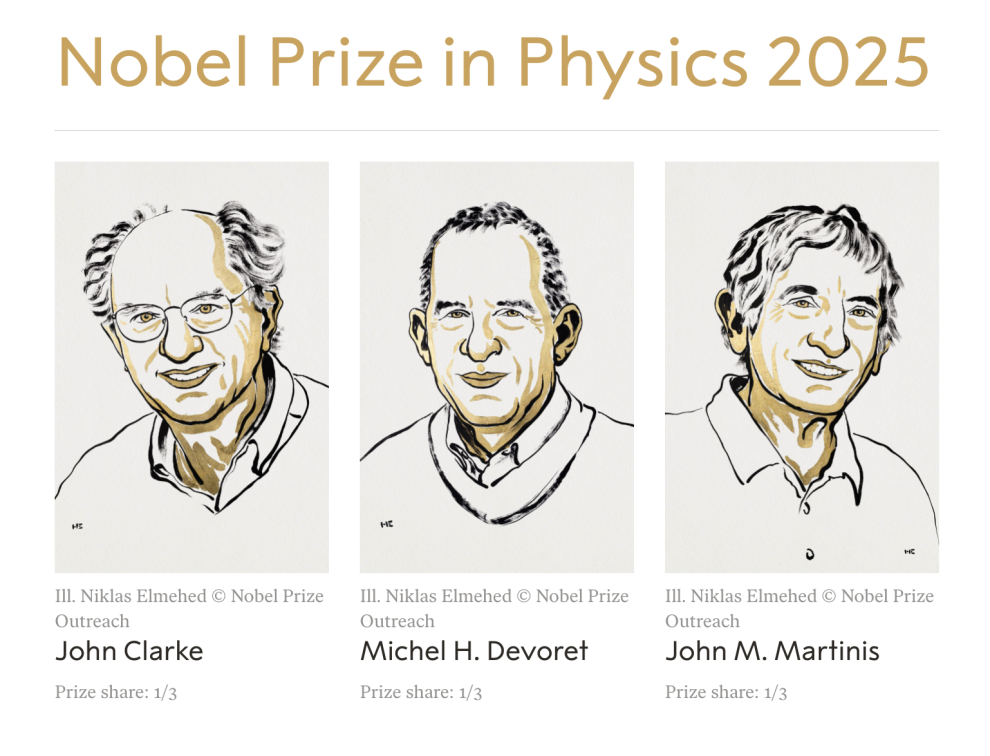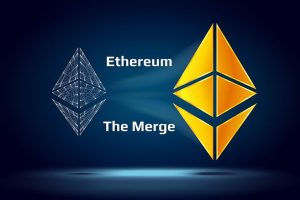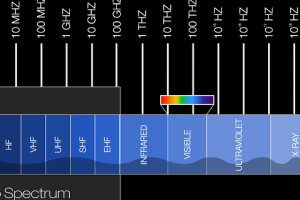9 October 2025: We have replaced our initial short announcement with this full-length Focus story.
Quantum particles can penetrate through barriers, a behavior called tunneling. But large objects consisting of billions of particles can also display tunneling behavior, as demonstrated by the recipients of this year’s Nobel Prize in Physics, John Clarke from the University of California (UC), Berkeley; Michel Devoret from Yale University; and John Martinis from UC Santa Barbara. Using a superconducting circuit, they showed that the superconducting electrons, acting as a collective unit, can tunnel across an energy barrier between two quantum states. The work thrust open the field of superconducting circuits, offering a basis for subsequent advances in quantum computing.
This year is the International Year of Quantum Science and Technology, so it is perhaps fitting that the Nobel committee selected quantum tunneling for this year’s physics prize. Tunneling is quintessentially quantum, since “going through walls” flies in the face of our classical intuition. And yet, this is not the first Nobel for tunneling. Half of the 1973 physics prize went to Japanese physicist Leo Esaki and Norwegian-American physicist Ivar Giaever for experiments on tunnelling in semiconductors and superconductors. The other half went to Welsh physicist Brian Josephson for predictions of tunneling across barriers—now called Josephson junctions in superconducting circuits.
That earlier work on quantum tunneling considered how a single quantum particle behaves at a barrier. The basic model assumes that the particle’s quantum wave function penetrates into the barrier but with an exponentially suppressed amplitude. As a result, the particle has some small probability of appearing on the opposite side of the barrier. That probability can explain, for example, the rate at which alpha particles tunnel out of radioactive nuclei.

Quantum theory does not restrict tunneling to the smallest particles. A large object is made of many particles whose collective wave function can in principle penetrate a barrier. The challenge, however, is that environmental disturbances can easily disrupt the collective wave function and destroy the possibility of tunneling. A suggestion was made at the beginning of the 1980s that superconducting circuits might be “environmentally quiet” enough to allow for macroscopic tunneling [4]. Several experiments looked for the effect, but the evidence was ambiguous because of noise in the circuits.
Clarke, Devoret, and Martinis (all working at UC Berkeley at the time) designed an experiment that overcame the noise problem. Their system was a centimeter-wide superconducting circuit containing a Josephson junction. The superconducting electrons in the circuit form a collective system, essentially a macroscopic object, described by a single quantum phase. Previously developed models showed that this multielectron object can exist in one of two states, corresponding to zero voltage and nonzero voltage across the junction. These two states are separated from each other by an energy barrier, which one can imagine as a steep hill between two valleys.
In a departure from previous experiments, the team used microwaves—injected through wires as an alternating current—as the means to control and measure the parameters of the circuit. “The microwaves provided an extra dimension that was absolutely critical to pinning down what was going on and revealing the quantum-mechanical behavior,” Martinis says.
The researchers initialized the circuit in the zero-voltage state, effectively trapping the multielectron object on one side of the energy barrier. But the object could still “escape” (observable as a sudden switch in the voltage) thanks to thermal fluctuations that gave it enough energy to climb over the barrier. They found that, as expected, the escape rate decreased as they cooled the system. However, below 50 mK the escape rate stopped dropping with temperature and instead remained constant—evidence that the object was tunneling through the barrier without any need of thermal fluctuations.
Using their microwave input, the researchers could also excite the superconducting electrons in their zero-voltage “valley” and observe the effect on the tunneling. They found that—just as an atom has quantized energy levels—the multielectron object has a discrete ladder of higher energy states. “We showed that you could build and customize a kind of artificial atom,” Martinis says.
This ability to engineer atom-like behavior in a macroscopic device attracted a lot of interest in the years that followed. “It was kind of a surprise to have a human-made object following the same kind of equation, the Schrödinger wave equation, that an atom would,” says Yasunobu Nakamura from the University of Tokyo. He and others later refined the superconducting circuit technology, showing that the multielectron system could effectively inhabit two states at once—a quantum superposition [5]. Subsequent work led to devices that could store and process quantum information, and now superconducting circuit technology is one of the most popular platforms for quantum bits (see Viewpoint: A Superconducting Qubit that Protects Itself). “The pioneering work of the Berkeley team really opened up our field,” Nakamura says.
The 2025 Nobel Prize in Physics highlights macroscopic quantum tunneling and energy quantization. Chris Porter from IBM Quantum explains the groundbreaking experiments by John Clark, Michelle Devet, and John Martinez. The video shows how quantum behavior can appear in superconducting circuits and how this research laid the foundation for today’s quantum computers.
When Quantum Becomes Macroscopic
The 2025 Nobel Prize shows that quantum mechanics isn’t confined to atoms or electrons it can govern large, human-made systems. Clarke, Devoret, and Martinis proved that billions of superconducting electrons can behave as a single quantum entity, tunneling through energy barriers and exhibiting discrete energy levels like an artificial atom.
This work bridges microscopic theory and macroscopic reality, demonstrating that quantum phenomena can be engineered and controlled in circuits large enough to touch. It laid the foundation for superconducting qubits, the building blocks of modern quantum computers, and shows that with careful design, environmental noise can be minimized to reveal pure quantum behavior.
The key insight: quantum rules are not just for the tinythey can govern collective systems, opening new horizons for computing, sensing, and our understanding of reality itself.















Add Comment